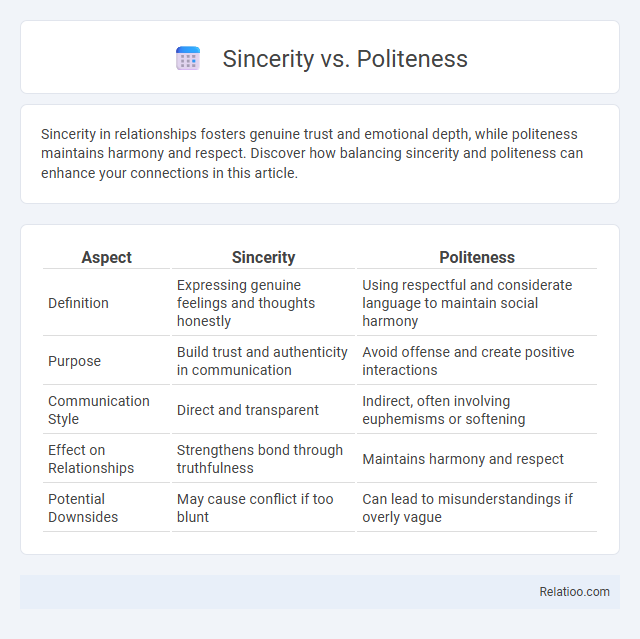Sincerity in relationships fosters genuine trust and emotional depth, while politeness maintains harmony and respect. Discover how balancing sincerity and politeness can enhance your connections in this article.
Table of Comparison
| Aspect | Sincerity | Politeness |
|---|---|---|
| Definition | Expressing genuine feelings and thoughts honestly | Using respectful and considerate language to maintain social harmony |
| Purpose | Build trust and authenticity in communication | Avoid offense and create positive interactions |
| Communication Style | Direct and transparent | Indirect, often involving euphemisms or softening |
| Effect on Relationships | Strengthens bond through truthfulness | Maintains harmony and respect |
| Potential Downsides | May cause conflict if too blunt | Can lead to misunderstandings if overly vague |
Understanding Sincerity: Defining True Expression
Understanding sincerity involves recognizing genuine expression that reflects true feelings and intentions without pretense or manipulation. Unlike politeness, which focuses on social harmony and often involves masking true thoughts for courtesy, sincerity prioritizes honesty and authenticity in communication. True sincerity builds trust by aligning words with inner beliefs, fostering meaningful and transparent interactions.
What Is Politeness? Social Etiquette Explained
Politeness is a fundamental aspect of social etiquette that involves showing respect and consideration for others through courteous language and behavior. Unlike sincerity, which emphasizes genuine feelings and honesty, politeness often requires regulating your expressions to maintain harmony and avoid offense in social interactions. Understanding the balance between politeness and sincerity is essential for navigating social dynamics and ensuring your communication is both respectful and authentic.
The Roots of Sincerity and Politeness
The roots of sincerity lie in genuine expression, authenticity, and heartfelt intention, emphasizing truthfulness and trustworthiness in communication. Politeness originates from social norms, cultural expectations, and the desire to maintain harmony and respect within interpersonal interactions. Understanding these foundations reveals how sincerity fosters deep connections, while politeness facilitates smooth social functioning.
Cultural Perspectives: Politeness vs Sincerity Around the World
Cultural perspectives on politeness and sincerity vary significantly, with some societies valuing indirect communication to maintain harmony, while others prioritize straightforward honesty. In many East Asian cultures, politeness often involves preserving face and showing respect, sometimes at the expense of blunt sincerity, whereas Western cultures may emphasize candidness as a form of genuine interaction. Understanding these differences can help you navigate social interactions with sensitivity, balancing politeness and sincerity appropriate to diverse cultural contexts.
When Sincerity Hurts: The Risks of Brutal Honesty
When sincerity turns into brutal honesty, it risks damaging relationships by prioritizing truth over others' feelings, often causing unintended emotional harm. Politeness serves as a social buffer, softening harsh truths to maintain harmony, but excessive politeness can lead to misunderstandings or perceived insincerity. Balancing honesty with empathy ensures that communication remains truthful yet respectful, preserving trust without inflicting unnecessary pain.
The Benefits of Politeness in Everyday Interactions
Politeness fosters positive social interactions by creating an atmosphere of respect and consideration, which enhances communication and reduces conflicts. Demonstrating politeness encourages trust and cooperation in both personal and professional relationships, leading to more productive and harmonious exchanges. Consistently practicing polite behavior improves emotional intelligence and social skills, contributing to long-term relationship success and social acceptance.
Striking a Balance: Harmonizing Sincerity and Politeness
Striking a balance between sincerity and politeness requires acknowledging your true feelings while expressing them with respect and tact. Mastering this harmony fosters genuine communication that builds trust without causing unnecessary offense. Your ability to blend honesty with kindness enhances relationships and promotes constructive dialogue.
Real-Life Scenarios: Sincerity or Politeness?
In real-life scenarios, sincerity involves expressing genuine thoughts and feelings, fostering trust and authenticity in relationships. Politeness prioritizes social harmony by using courteous language and behavior, often softening or masking true opinions to avoid conflict. Balancing sincerity and politeness depends on context; being sincere is crucial in personal and critical conversations, while politeness helps maintain respect and smooth interactions in formal or delicate situations.
Impacts on Relationships: Trust, Respect, and Boundaries
Sincerity fosters genuine trust and deeper respect in relationships by promoting honesty and transparency, allowing you to build authentic connections. Politeness helps maintain social harmony and respects boundaries, but excessive politeness without sincerity may create misunderstandings or superficial interactions. Balancing sincerity and politeness ensures that trust is nurtured while preserving respect for personal boundaries, strengthening the overall quality of your relationships.
Choosing Wisely: When to Prioritize Sincerity or Politeness
Choosing wisely between sincerity and politeness depends on context, relationship, and desired outcome, as sincerity fosters trust and authenticity while politeness ensures social harmony and respect. Prioritizing sincerity is crucial in close relationships and situations requiring transparency, whereas politeness is often preferred in professional or formal interactions to maintain decorum. Balancing both involves assessing the impact of honesty versus tact to communicate effectively without causing undue offense or misunderstanding.

Infographic: Sincerity vs Politeness
 relatioo.com
relatioo.com